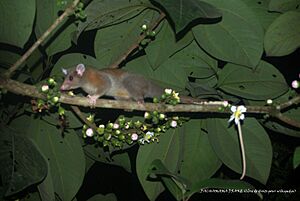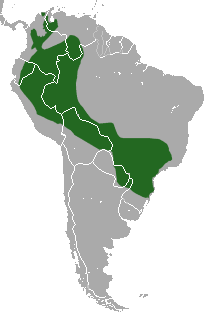Brown-eared woolly opossum facts for kids
Quick facts for kids Brown-eared woolly opossum |
|
|---|---|
 |
|
| Caluromys lanatus | |
| Conservation status | |
| Scientific classification | |
| Genus: |
Caluromys
|
| Species: |
lanatus
|
| Subspecies | |
|
|
 |
|
| Brown-eared woolly opossum range | |
The brown-eared woolly opossum (Caluromys lanatus), also known as the western woolly opossum, is a type of opossum. It lives in South America. A German scientist named Ignaz von Olfers first described it in 1818.
This opossum has a brown or reddish-brown coat. Its legs are also brown. Its belly is yellow to orange. Its ears are brown and hairless, with a little pink color. Its tail has fur on the top half. The brown-eared woolly opossum is nocturnal, meaning it is active mostly at night. It lives alone and eats many different things. The IUCN says it is a species of least concern, which means it is not currently in danger.
Contents
About the Brown-Eared Woolly Opossum
The brown-eared woolly opossum is part of a group called Caluromys. This group belongs to the Didelphidae family, which includes all opossums. Ignaz von Olfers first named it Didelphys lanata in 1818. Later, an American zoologist named Joel Asaph Allen gave it its current scientific name, Caluromys lanatus, in 1900.
Scientists often study how different animals are related. In 1955, some scientists thought that Caluromys was closely related to a few other opossums. But later studies showed that these animals just looked similar because they adapted to similar environments.
There are four main types, or subspecies, of the brown-eared woolly opossum:
- C. l. cicur: Found in northeastern Colombia and northwestern Venezuela.
- C. l. lanatus: Lives in Bolivia and a part of southwestern Brazil called Mato Grosso.
- C. l. ochropus: Found in western Brazil, southeastern Colombia, eastern Ecuador, Peru, and southern Venezuela.
- C. l. ornatus: Lives in southern Colombia, the lowlands of Bolivia, Ecuador, Peru, and the eastern Andes mountains.
What Does It Look Like?
The brown-eared woolly opossum has fur that can be brown or reddish-brown. Its legs are the same color. Its belly is yellow or orange. Its ears are brown and don't have much hair, sometimes with a pink tint. The top half of its tail is covered in fur. The fur on its back is long, soft, and thick.
Sometimes, its fur can have a gray color. It might look more orange on its shoulders, legs, and the top of its head. Young opossums are usually grayer. The end of its tail has less fur, and the last part is bare. This bare part is usually white with a yellowish color and brown spots. It has light orange rings around its eyes on its grayish-white face. A dark stripe goes from its nose, between its eyes, and up to the back of its ears.
Different subspecies can have slightly different colors. For example, C. l. circur is mostly grayish-brown. C. l. lanatus is a pale brown and doesn't have spots on its tail.
Its body, not including the tail, is about 20 to 32 centimeters (8 to 13 inches) long. Its tail is longer, measuring 33 to 45 centimeters (13 to 18 inches). This opossum weighs about 31 to 52 grams (1.1 to 1.8 ounces). Its back feet are 3 to 5 centimeters (1.2 to 2 inches) long, and its ears are 3 to 4 centimeters (1.2 to 1.6 inches) long.
The brown-eared opossum has a bushier tail than the bare-tailed woolly opossum. Also, its pouch opens to the front, not down the middle. The Derby's woolly opossum has white legs and gray fur between its shoulders, which is different from the brown-eared opossum.
Where Does It Live?
The brown-eared woolly opossum lives in warm, wet tropical forests. This includes old-growth forests, newer forests, and forests along rivers. It can also be found in plantations, mangrove forests, and dry forests. Sometimes, it even lives in the more wooded parts of the cerrado and pantanal areas.
It usually lives up to 500 meters (1,600 feet) above sea level. However, some have been found as high as 2,600 meters (8,500 feet). Its home range is east of the Andes mountains. This includes Bolivia, central Colombia, eastern Ecuador, Peru, and western and southern Venezuela. It also lives in northeastern Argentina, western, central, and southern Brazil, and eastern and southern Paraguay.
The IUCN says this opossum is of least concern. This is because it lives in many places and there are likely many of them. However, in some areas, its home is being lost due to deforestation.
How Does It Live?
The brown-eared woolly opossum is nocturnal, meaning it is active at night. It usually lives alone. But sometimes, two opossums have been seen looking for food together. These opossums are omnivorous, which means they eat both plants and animals. They eat fruits from plants like Cecropia and Piper. They also eat nectar, small invertebrates (like insects), and small vertebrates (like tiny animals with backbones).
By eating nectar, these opossums might help pollinate flowers. For example, they could help Pseudobombax tomentosum and Quararibea cordata flowers. They are generally quiet animals.
Female opossums have a special time called an estrus cycle, which lasts 27 to 29 days. Before they have babies, they develop a pouch. A mother opossum usually has one to four babies at a time. This is fewer than the bare-tailed woolly opossum, which can have up to seven young.



